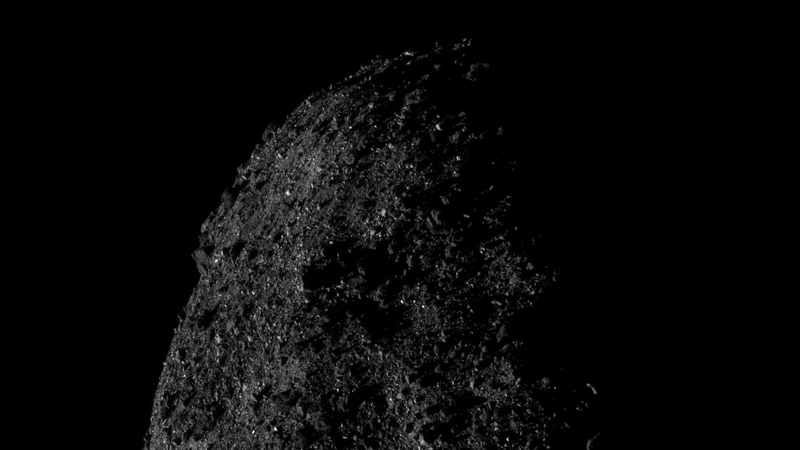 The asteroid Bennu, seen here after OSIRIS-REx’s “Orbital B” insertion.Photo: NASA/Goddard/University of Arizona/Lockheed Martin (https://www.asteroidmission.org/)
The asteroid Bennu, seen here after OSIRIS-REx’s “Orbital B” insertion.Photo: NASA/Goddard/University of Arizona/Lockheed Martin (https://www.asteroidmission.org/)
NASA’s asteroid-sampling OSIRIS-REx spacecraft, which is currently in position around the tiny, near-Earth asteroid 101955 Bennu, has transmitted its closest shot of the asteroid’s surface yet.
NASA has already released photos of OSIRIS-REx taken with the craft’s NavCam 1 navigation camera on January 17, 2019 from a distance of roughly a mile (1.6 kilometers) above its surface. Now, per the Verge, NASA has released a photo taken on June 13 from a circular orbit of just 0.4 miles (690 meters) above Bennu—described as the closest a spacecraft has ever orbited a body in the Solar System.
Behold the whole thing:
 Photo: NASA/Goddard/University of Arizona/Lockheed Martin (https://www.asteroidmission.org/)
Photo: NASA/Goddard/University of Arizona/Lockheed Martin (https://www.asteroidmission.org/)
From the release:
This image of asteroid Bennu was captured on Jun. 13, 2019, shortly after NASA’s OSIRIS-REx spacecraft executed its second orbital insertion maneuver. From the spacecraft’s vantage point in orbit, half of Bennu is sunlit and half is in shadow. Bennu’s largest boulder can also be seen protruding from the southern hemisphere. The image was taken from a distance of 0.4 miles (690 m) above the asteroid’s surface by NavCam 1, one of three navigation cameras that comprise the spacecraft’s TAGCAMS (the Touch-and-Go Camera System) suite. At this distance, details as small as 1.6 ft (0.5 m) across can be resolved in the center of the image.
OSIRIS-REx (Origins, Spectral Interpretation, Resource Identification, and Security – Regolith Explorer) launched in 2016 and arrived at Bennu in December 2018. It carries five data-taking instruments and is intended to carry out NASA’s first mission to return with samples from an asteroid.
OSIRIS-REx had already set history: Bennu is around just 1,700 feet (~520 meters) in diameter, making it the smallest object ever orbited by a spacecraft. Earlier this year, NASA scientists determined that Bennu’s surface is spewing material as well as craggier than previously thought, which will make a sample collection attempt more difficult.
According to mission scientists, OSIRIS-REx will continue to stay in its current orbit until mid-August, during which it will use instruments including the OSIRIS-REx Laser Altimeter (OLA) to create a full terrain map, PolyCam to “form a high-resolution, global image mosaic,” and the OSIRIS-REx Thermal Emission Spectrometer (OTES) and the REgolith X-ray Imaging Spectrometer (REXIS) to “produce global maps in the infrared and X-ray bands.” This is necessary to select the best landing site to minimize the chances of anything going wrong.
After that, OSIRIS-REx will rise to a higher orbit of around 0.8 miles (1.3 km). Sample collection using an instrument called the Touch-and-Go Sample Acquisition Mechanism (TAGSAM) is currently scheduled for summer 2020, while return to Earth is scheduled for 2023.
Japan’s similar Hayabusa2 mission successfully collected samples from the asteroid Ryugu using a tantalum bullet in February 2019, and later blasted a hole in it using an explosive device for another sample run. However, that second run hasn’t happened yet, and has a limited timetable to occur before Ryugu approaches too close to the sun for the mission to be viable.
[NASA/Goddard/University of Arizona/Lockheed Martin]
Share This Story